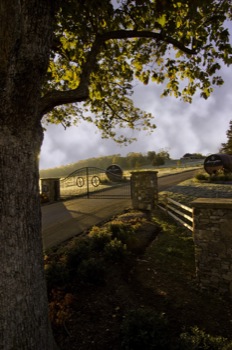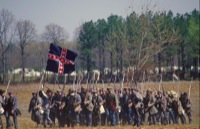
Today, national battlefields throughout Tennessee give visitors a chance to learn about these events that changed the course of our nation’s history.
Shiloh
“Bloody Shiloh,” one of the fiercest battles in American history, produced almost 24,000 casualties. Though technically a tie, historians consider Shiloh a Northern victory of great importance because Confederate leaders were forced to abandon the Mississippi Basin, and other Southern strongholds were threatened.
Shiloh National Military Park consists of more than 4,200 acres in western Tennessee. The visitors center displays soldiers’ personal belongings alongside cannons, muskets, swords and Union and Confederate flags that were carried into the battle. A 32-minute orientation film plays continually throughout the day.
The self-guided driving tour, with an optional audio CD, takes approximately 90 minutes and includes 14 interpretive stops. Each stop highlights an activity, area or building of significance in the battle. From Memorial Day to Labor Day, ranger programs cover infantry demonstrations and focus on specific aspects of the conflict.
 |
| Courtesy Shiloh National Battlefield |
“Many of the programs go in depth at the different stops,” said Marcus Johnson, natural resources manager for Shiloh National Military Park. “The rangers talk about how objectives, strategy and terrain all affected the battle’s outcome.”
The first tour stop is Pittsburg Landing on the Tennessee River, the principal site where Union soldiers landed by steamboat because of its proximity to Corinth, one of the Confederacy’s most critical railroad junctions.
“The Union objective for this battle was to take over Corinth,” said Johnson. “The shoreline along the river looks much the same, although the river is wider than it used to be.”
Another tour stop is the site where Confederate Gen. Albert Sidney Johnston was fatally wounded. He was shot in the back of the right leg, ironically, by friendly fire, and bled to death. Johnston, one of the most prominent Confederate generals, was the highest-ranking officer, Union or Confederate, killed during the Civil War.
www.nps.gov/shil/index.htm
Stones River Battlefield
Stones River National Battlefield, near Murfreesboro, commemorates the places where, in December 1862, the Union army suffered its greatest loss of life as a percentage of casualties. Despite the heavy casualties, the Union sustained a tactical victory because the Confederates left the area under Gen. Braxton Bragg.
“One of the rangers said that this battlefield could have been Gettysburg, but their daily casualties happened over two days instead of one,” said Cindy Dupree, director of communications for the Tennessee Department of Tourist Development.
Rangers recount the battle while overlooking the field from the visitors center. Three rooms commemorate the conflict and its aftermath, accompanied by an award-winning, nine-minute film.
“In the museum, an original Medal of Honor and a wooden headstone are on display,” said John McKay, education coordinator at the park.
www.nps.gov/stri/index.htm
Chickamauga and Chattanooga National Military Park
Chickamauga and Chattanooga National Military Park, which straddles the Tennessee and Georgia state lines, recounts the struggle for control of the Chattanooga region, the gateway to the deep South.
“Visitors like to follow the campaign chronologically from Chickamauga in September of 1863 to the battles for Chattanooga in November, which broke the Union siege,” said park ranger Anton Heinlein.
Starting at the 5,300-acre Chickamauga Battlefield, visitors center exhibits and audio-visual programs summarize the campaign; a seven-minute electric map presentation details the battle.
“Additionally, the center displays the Fuller Collection of American Military Shoulder Arms, which is one of the foremost collections of long arms in the country,” said park historian James Ogden. “With 346 weapons, it documents long arms from the Colonial period to World War I.”
The park’s audio tours, with optional visual images, can be played during the eight-stop, seven-mile driving tour. Groups can arrange for a ranger-led, step-on tour if a ranger is available.
“There’s plenty to see,” said Ogden. “Classes from the U.S. Army Command and General Staff College at Fort Leavenworth spend about 22 hours here after they study the battle for an entire semester.”
After the Union defeat at Chickamauga, the army retreated to Chattanooga and withstood a two-month siege before the battles of Lookout Mountain and Missionary Ridge.
The visitors center at Point Park in Lookout Mountain Battlefield, approximately 25 minutes northwest of Chickamauga, focuses on the battles and campaigns for Chattanooga.
“Most noteworthy is a 13-by-30-foot oil titled The Battle of Lookout Mountain painted in 1874 by English-born artist James Walker,” said Ogden. “CBS Good Morning recently highlighted this artist as a significant contributor to the Army’s art collection.”
Point Park’s sweeping views include much of Lookout Mountain Battlefield’s 3,000 acres, which include Chattanooga proper, the Chattanooga Valley and the Tennessee River. A short, self-guided walking tour highlights overlooks, monuments and tablets.
Artillery batteries with two 20-pound Parrot Rifled Cannons mark a small segment of the siege line that once encircled Chattanooga. Garrity’s Battery displays 12-pound “Napoleon” cannonballs, and Sunset Rock commemorates the spot where Confederate generals Bragg and James Longstreet watched Union troops enter Lookout Valley.
Finishing the campaign chronologically just east of Chattanooga, take Crest Road, which runs atop Missionary Ridge through residential areas. The road provides access to monuments, markers and plaques commemorating the campaign’s final conflict, which ended the siege on Union forces in Chattanooga.
www.nps.gov/chch/index.htm









